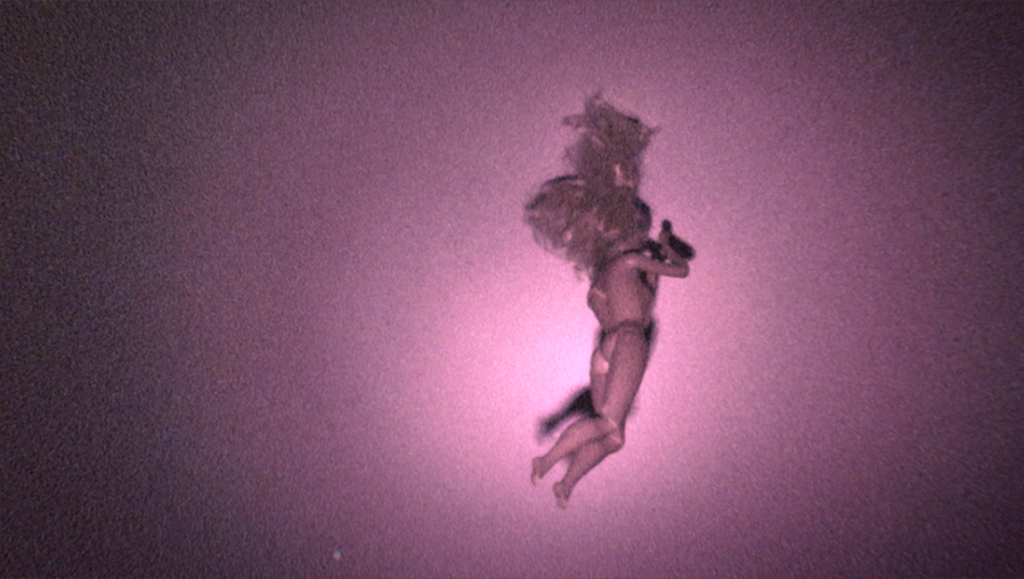It’s something of a fool’s errand to try to trace broad trends throughout a full festival lineup — most critics don’t see anywhere near the entirety of what’s actually exhibited, and fests like Fantasia are purposefully very, very large, offering a huge variety of modes and genres. Still, when one watches multiple films in a compressed amount of time, the mind can’t help but tease out links and connections. To wit, the most interesting films I’ve come across at Fantasia 2022 have experimented with a range of formats in an attempt to get at something deeper than simple narrative beats; Mitchell Stafiej’s The Diabetic combines digital video with low-gauge 8mm and 16mm film; Chris Osborn’s Gussy invokes memories of old VHS tapes and CRT TVs; Park Sye-young’s The Fifth Thoracic Vertebra is lit almost entirely by soft, woozy neon. The point is that all of these films possess a formal quality that goes beyond “mood” and into a more experiential, even epistemological space. Without simply resorting to cliched first-person point-of-view shots, these films nonetheless crawl entirely into their characters’ heads. None do that moreso than Kyle Edward Ball’s stunningly strange, deeply unnerving Skinamarink.
Shot in seven days in Ball’s childhood home, Skinamarink transforms a simple suburban house into a nightmarish dreamscape haunted by some unfathomable specter. Taking its gibberish title from an old children’s song, the film fully commits to the logic of a terrified kid — the rational and irrational become mixed up, turned upside down, defamiliarized. The film’s extremely minimal plot involves two very young children, Kevin (Lucas Paul) and Kaylee (Dali Rose Tetreault), who awake in the middle of the night to find all the doors and windows in their home gone. Waiting for their parents to come and find them, the children watch TV and hang out on the couch until they begin hearing voices and seeing strange things. Ball and cinematographer Jamie McRae have made the odd but ultimately effective choice to never fully show any of their actors. There are only four characters in the movie, the children and parents, and they are captured in oblique angles, frequently from the back of the head, from a distance, or as disembodied arms and legs (with one very effective exception). The actors playing mom and dad are heard but not seen, silhouettes that have become threatening instead of comforting. A dark, guttural voice occasionally beckons the children to go someplace or another, each hallway and room in the home suggesting some kind of unknowable horror just out of frame. The house is a labyrinth of liminal spaces, and it’s alarmingly dark.
Combining practical, on-set lighting, a digital camera capable of shooting in extreme low light, and a rigorous post-production process, Ball has constructed the film almost as a series of still photographs. The sharp 2:35:1 widescreen frame, coupled with a blizzard of fuzzy (digitally added) film grain, literally feels wrong, in the sense that scope images simply do not typically look like this. Ball has truly tapped into the uncanny, transforming the quotidian into something strange and unknowable. The interior architecture of the home is reduced to a series of sharp edges and hard straight lines, light fixtures become abstract objects, and the children’s own toys take on ominous portent. The dull hum of a TV in the background casts a hazy glow over certain rooms, the noises from old black and white cartoons filling the air. The dense grain turns dark corners into eerie voids, every texture alive with subliminal movement. The soundtrack is entirely post-synch ADR, recorded separately after principal photography, and layered with a series of hisses and pops that sound like an aged, warped vinyl record. The children’s dialogue is mostly unintelligible, some of it relayed via subtitles that pop up on-screen, but which only transcribe bits and pieces of sentences. Like everything else in the movie, they too become unsettling simply by virtue of being incomplete, incorrect, just slightly wrong.
The lack of traditional story and absence of normal characters can make Skinamarink difficult to connect to, and its repetitive, somnambulist rhythms are perhaps a little too lulling. Frankly, one might be forgiven for dozing off. But for adventurous viewers who can attune themselves to its very peculiar wavelength, the film contains some of the most unsettling imagery in recent memory. It’s a true sensory experience, and a testament to low-budget ingenuity. Just be ready to sleep with the lights on.
Published as part of Fantasia Film Festival 2022 — Dispatch 6.


Comments are closed.